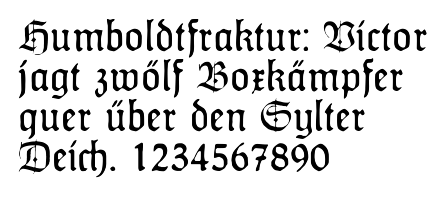Fraktur: Difference between revisions
Someone else (talk | contribs) regnal dates |
m links |
||
| Line 17: | Line 17: | ||
Isolated Fraktur letters are also used in [[mathematics]], e.g. to denote [[Lie groups]]. ''(is this correct?)'' |
Isolated Fraktur letters are also used in [[mathematics]], e.g. to denote [[Lie groups]]. ''(is this correct?)'' |
||
''(The German sentence in the figures reads: "Victor jagt zwölf Boxkämpfer quer über den Sylter Deich". This is patent nonsense, meaning "Victor chases twelve box fighters across the dam of Sylt", but contains all 26 letters of the alphabet plus the German [[umlauts]] and thus |
''(The German sentence in the figures reads: "Victor jagt zwölf Boxkämpfer quer über den Sylter Deich". This is patent nonsense, meaning "Victor chases twelve box fighters across the dam of [[Sylt]]", but contains all 26 letters of the alphabet plus the German [[umlauts]] and is thus an example of a [[pangram]].)'' |
||
== Related articles == |
== Related articles == |
||
Revision as of 23:13, 19 May 2003
The German word Fraktur (pronounced "frahk-TOOR") refers to a family of typefaces. The term derives from the past participle of Latin frangere ("to break"), fractus ("broken"). As opposed to Antiqua (common) typefaces, modelled after antique Roman writing, the lines in Fraktur letters are broken up, approximating handwriting. In this broad sense, some refer to handwriting itself as Fraktur also.
Fig. 1: Walbaum-Fraktur (1800)

Fig. 2: Humboldtfraktur
(Hiero Rhode, 1938)

Fig. 3: Werbedeutsch
(Herbert Thannhaeuser, 1934)
In a more narrow sense, the term "Fraktur" refers to a number of blackletter typefaces, which are commonly divided into "Gothic", "Schwabacher", and "Fraktur" fonts. See the "typeface" article for detail.
The first Fraktur typeface was designed when Emperor Maximilian I (r. 1493-1519) established a series of books and had a new typeface created specifically for this purpose. Fraktur quickly overtook the earlier Schwabacher and Gothic typefaces in popularity, and a wide variety of Fraktur fonts was carved.
As opposed to other countries, in Germany, typesetting in Fraktur was entirely common still in the 19th century. Some books from the time used Schwabacher still; however, the predominant typeface was the Normalfraktur (Fig. 1), which came in various slight variations.
Fraktur went out of fashion during the early 20th century because of the obvious communication problems with non-native German speakers. However, in an attempt to deliberately differentiate Germany from the rest of the Western world, it was reinforced by Nazi Germany (1933-1945), which pronounced that Antiqua typefaces were not Aryan. During that time, new, more artificial Fraktur typefaces were designed (see Fig. 2 and 3). This policy was officially held up until January 3, 1941, when Martin Bormann issued a circular letter to all public offices which suddenly declared Fraktur to be Judenlettern (Jewish letters) and prohibited further use. It has been speculated that the regime had realized that Fraktur would inhibit communication in the territories occupied during World War II as well.
Despite being an old German tradition, the use of Fraktur therefore has a strong Nazi connotation to many. Today, Fraktur is thus merely used for decorative typesetting any more; for example, a number of traditional German newspapers still print their name in Fraktur on the first page.
Isolated Fraktur letters are also used in mathematics, e.g. to denote Lie groups. (is this correct?)
(The German sentence in the figures reads: "Victor jagt zwölf Boxkämpfer quer über den Sylter Deich". This is patent nonsense, meaning "Victor chases twelve box fighters across the dam of Sylt", but contains all 26 letters of the alphabet plus the German umlauts and is thus an example of a pangram.)
Related articles
Sources, external links
- Information about Schwabacher (in German)
- Website of Dieter Steffmann (has a large number of digitized Fraktur fonts, in English)
- http://www.asherwin.com/frakturscript2.html
- http://www.waldenfont.com/products/kur/history.asp
- http://www.cooper.edu/art/lubalin/bletterpub.html
